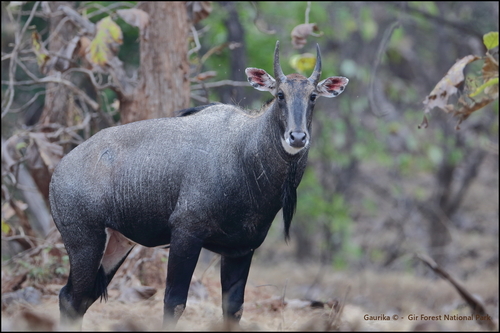
Nilgai
The nilgai (Boselaphus tragocamelus), or blue bull, stands as Asia's largest antelope. Males sport a striking blue-grey coat, while females are tawny. Inhabiting India's grasslands, these diurnal grazers are vital seed dispersers, showcasing nature's balance in their dynamic ecosystem.
21 years
Lifespan
119.75 - 287.66 kg
Weight
Length: 1.803 - 2.007 m; Height: 1.19 - 1.5 m
Size
Brown, Grey, Yellow, Blue, Light-Brown
Color
3 years
Age of Sexual Maturity
10 months
Age of Weaning
29 mph
Top Speed
Least Concern
Conservation Status
Stable
Population Trend
Characteristics
The Boselaphus tragocamelus, commonly known as the nilgai or blue bull, is the largest Asian antelope. It inhabits grasslands and woodlands in the Indian subcontinent. The species is notable for its sexual dimorphism, with males sporting a bluish-grey coat and small, conical horns, while females are tawny brown and hornless. Nilgai are diurnal, primarily grazing on grasses and leaves, and play a key role in seed dispersal in their ecosystem.
Distribution Range of the Nilgai
The Boselaphus tragocamelus, commonly known as the Nilgai or blue bull, is native to the Indian subcontinent. It is primarily found in India, with smaller populations in Nepal and Pakistan. The species is most prevalent in the northern and central parts of India.
Nilgai's Habitat
Environmental Conditions
Nilgai are typically found in dry deciduous forests, scrub forests, and grasslands. They are well adapted to arid and semi-arid environments, often inhabiting regions with sparse vegetation. These areas can range from plains to low hills, and they often prefer areas with a mix of open land and scattered trees or shrubs.
Ecological Niche
As large herbivores, Nilgai play a crucial role in their ecosystem by influencing vegetation patterns and serving as prey for large predators such as tigers and leopards. They are browsers and grazers, feeding on a variety of grasses, leaves, and fruits, which allows them to adapt to different types of vegetation across their range. Their ability to thrive in disturbed habitats also makes them important for maintaining ecological balance in agricultural landscapes.
Copyright @ Nature Style Limited. All Rights Reserved.
 English
English